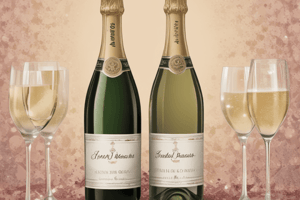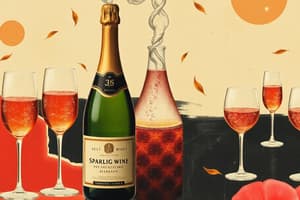Podcast
Questions and Answers
How are the bubbles created in sparkling wines?
How are the bubbles created in sparkling wines?
Dissolved carbon dioxide gas (CO2)
What are the two methods of making sparkling wine?
What are the two methods of making sparkling wine?
- Carbonic maceration
- Bottle fermentation (correct)
- Sparkling infusion
- Tank fermentation (correct)
What is the base wine for sparkling wines like?
What is the base wine for sparkling wines like?
Dry, high in acidity, low in alcohol, usually a blend of different vintages, varieties, villages.
What makes the bubbles in most sparkling wines?
What makes the bubbles in most sparkling wines?
How is the second fermentation started?
How is the second fermentation started?
Where does fermentation take place for sparkling wine?
Where does fermentation take place for sparkling wine?
What is bottle fermentation?
What is bottle fermentation?
What is the process of riddling?
What is the process of riddling?
What is disgorgement in sparkling wine production?
What is disgorgement in sparkling wine production?
What is dosage in sparkling wine production?
What is dosage in sparkling wine production?
What does liqueur d'expedition refer to?
What does liqueur d'expedition refer to?
What is brut in relation to sparkling wines?
What is brut in relation to sparkling wines?
What is demi-sec in sparkling wines?
What is demi-sec in sparkling wines?
What is the traditional method in sparkling wine production?
What is the traditional method in sparkling wine production?
How many varieties of base wine are used in Champagne?
How many varieties of base wine are used in Champagne?
What is the legal minimum amount of time aged on the lees in Champagne?
What is the legal minimum amount of time aged on the lees in Champagne?
What are some famous bottle fermented sparkling wines?
What are some famous bottle fermented sparkling wines?
Where does Cava come from?
Where does Cava come from?
What are the grape varieties used to make Cava?
What are the grape varieties used to make Cava?
What flavors are typical in Cava?
What flavors are typical in Cava?
What is the climate in Champagne?
What is the climate in Champagne?
Flashcards are hidden until you start studying
Study Notes
Sparkling Wines Overview
- Bubbles in sparkling wines are primarily created by dissolved carbon dioxide (CO2); can be artificially added or naturally produced during fermentation.
- Two key methods for making sparkling wine: bottle fermentation and tank fermentation.
Base Wine Characteristics
- Typical base wine for sparkling wines is dry, high in acidity, and low in alcohol, often a blend of various vintages, grape varieties, and regions.
Second Fermentation Process
- Second fermentation is crucial for producing bubbles, initiated by adding sugar and yeast to dry base wine, resulting in an increase of alcohol content by about 1.5%.
- This fermentation occurs in sealed vessels, either bottles (bottle fermentation) or tanks (tank fermentation).
Bottle Fermentation
- Also referred to as the traditional method; involves several key steps:
- Addition of sugar and yeast to base wine, bottle sealed with crown cap, placed on its side.
- Yeast forms sediment (lees) in the bottle, leading to autolysis, which contributes flavors like bread and biscuit to the wine.
- Prolonged contact with lees intensifies these flavors.
Riddling and Disgorgement
- Riddling is the process of shifting lees from the side of the bottle to the neck, done slowly by hand or with gyro-palettes.
- Disgorgement involves freezing the neck of the bottle to remove the lees as a plug of ice when the crown cap is removed, using CO2 pressure.
Dosage and Sweetness Levels
- Dosage: Before resealing, a mixture of wine and sugar is added, determining the final sweetness of the sparkling wine.
- Common sweetness levels include:
- Brut: Minimal sugar, high acidity, lively bubbles.
- Demi-sec: Medium sweetness with higher sugar content.
Traditional Method Steps
- The traditional method includes:
- Creation of base wine
- Second fermentation
- Riddling
- Disgorgement
- Dosage
- Resealing with a thick cork and wire cage.
Key Sparkling Wines
- Notable bottle-fermented sparkling wines include Champagne, Cava, and Methode Cap Classique.
Champagne Facts
- Champagne originates from Northern France in a cool climate.
- Base wine typically uses three grape varieties: Chardonnay, Pinot Noir, and Pinot Meunier.
- Non-vintage (NV) Champagnes are blends from multiple vintages.
- Legal minimum aging on lees is 12 months for the least expensive quality.
Cava Specifics
- Cava, a Spanish sparkling wine from Catalunya, is characterized by neutral fruit flavors and medium acidity, primarily using local varietals but can also include Chardonnay and Pinot Noir.
- Most Cava is best enjoyed soon after release.
Regional Sparkling Wines
- South Africa, California, Australia, and New Zealand are cooler regions known for high-quality sparkling wines, often using Chardonnay and Pinot Noir as base grapes.
- Methode Cap Classique indicates South African use of the traditional method.
Alternative Methods and Sweet Wines
- Tank method is less labor-intensive and avoids autolytic flavors; base wine, sugar, and yeast are added to a tank, filtered to remove lees, then bottled under pressure.
- Asti DOCG from Piedmont, Italy, produces sweet, fruity wines from the Moscato grape, characterized by floral aromas and flavors of peaches and pears.
Prosecco Methodology
- Prosecco DOC employs the tank method using Glera as the base wine, resulting in light to medium-bodied wines with flavors of apple and melon, available in dry or off-dry styles.
Studying That Suits You
Use AI to generate personalized quizzes and flashcards to suit your learning preferences.




